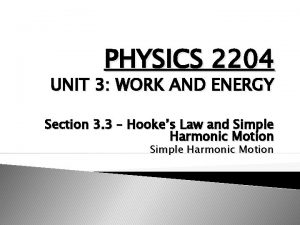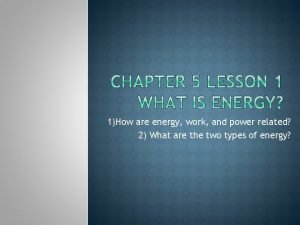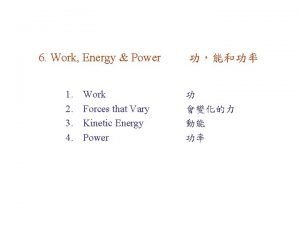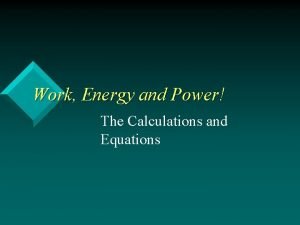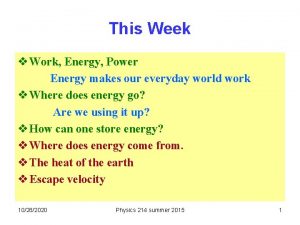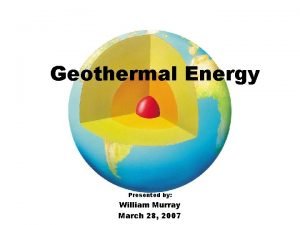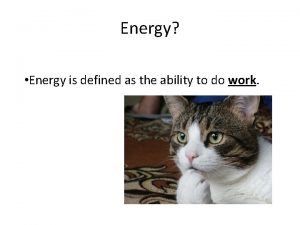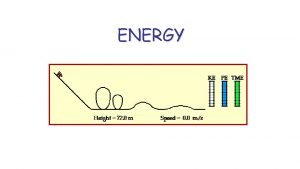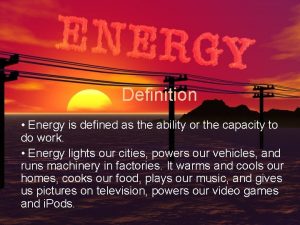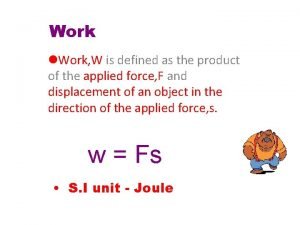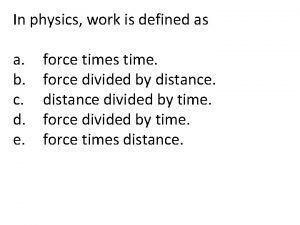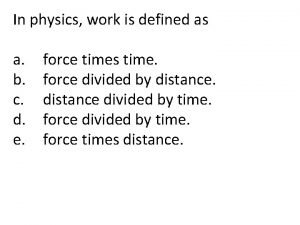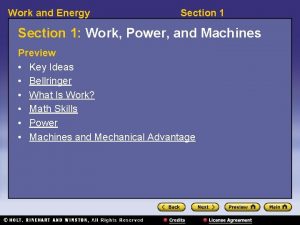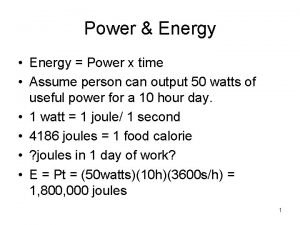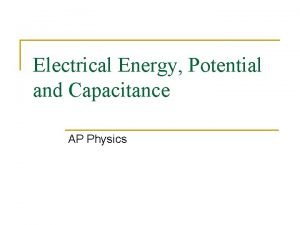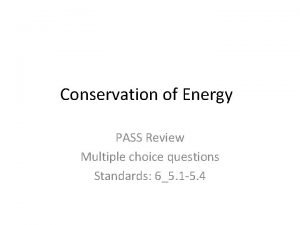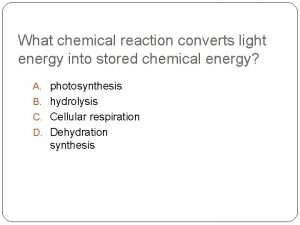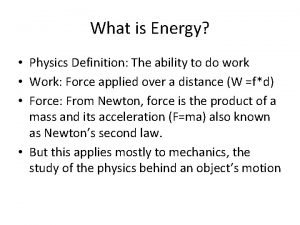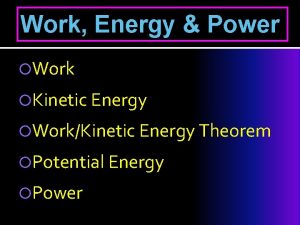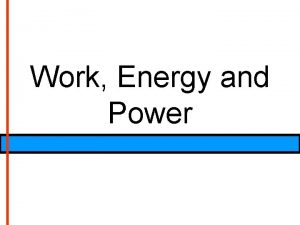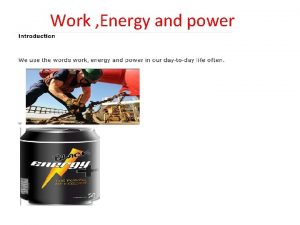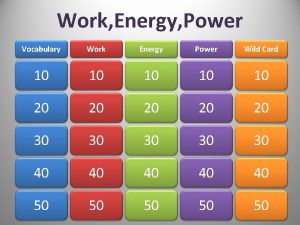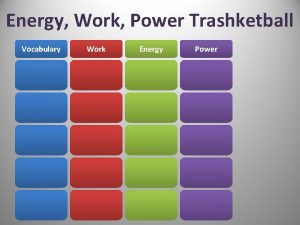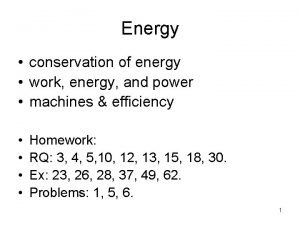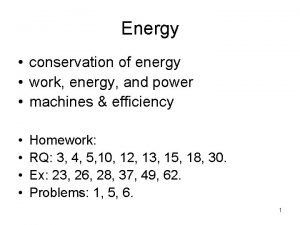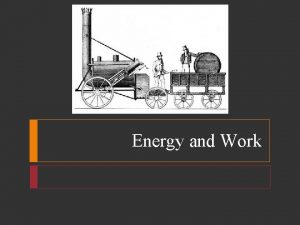PTSOS Work Energy Power Work defined F d













































































- Slides: 77

PTSOS – Work, Energy, & Power

Work defined F d Work = the product force F exerted and resulting displacement d: W = Fd

Units: W = Fd Joules (J) meters (m) Newtons (N)

Remember… If you work hard… …you can make a lot of money… … and buy a lot of jewels joules!

So, W = Fd Recall Newton’s 2 nd law: F = ma. If you substitute Newton’s 2 nd Law into the formula for work you get: W = mad A simple, yet elegant proof that work makes you mad!

What if F isn’t parallel to d? d F

Only the component of F parallel to d contributes to work. F|| d θ So, W = F||d, where F|| = F cos θ Thus, W = Fd cos θ F

Work & Machines No device can perform more joules of work in order to accomplish a task than the number of joules of work that are input into the machine by the user. (In other words, machines cannot create energy. ) A simple machine, however, is a device that can alter the magnitude or direction of the force it takes to accomplish a task. Since W = Fd, if a machine lessens the amount of force F necessary to accomplish a task, and W must remain the same (or even greater – but we’ll get to that in a moment!), the price you pay for using the machine is having to exert your force over a longer distance d.

Example of a Simple Machine: The Inclined Plane Suppose you want to lift a 1000 -N refrigerator into the back of a moving truck 0. 75 m off the ground. Fout dout Without the ramp, you’d have to actually exert 1000 N of force straight up over a distance of 0. 75 m. These values can be considered the output force and output distance of the machine, respectively.

Example of a Simple Machine: The Inclined Plane The ramp, however, lets the user apply a force much smaller than the actual weight of the fridge. Fin Fout din dout The price the user pays is having to exert that smaller force over a longer distance, in this case the length of the ramp.

In an ideal machine, Wout = Win If the ramp is 3. 0 m long, how much effort force should the user need to input? Fin Fout Assuming ideal conditions, din Foutdout = Findin dout (1000 N)(0. 75 m) = F (3 m) in So, Fin = 250 N

Realistically, no machine is ideal Instead of ideal conditions, suppose the user has to over come 50 N of friction on the ramp Fin Fout din dout In this case, the actual input force would be Fin = 250 + 50 = 300 N.

Work in v. Work out Win = Findin = (300 N)(3 m) = 900 J Wout = Foutdout = (1000 N)(0. 75 m) = 750 J Efficiency is defined as the ratio of useful output work to amount of input work: Fin Fout din dout η = Wout/Win In this case, η = 750 J/900 J = 0. 83, or 83%

Work in v. Work out 83% of the energy exerted by the user translated into actual useful work done; the other 17% was used overcoming friction. So 900 J of work was input in order to accomplish a 750 J task Fin Fout Was it worth it? din dout Probably, unless you want a back injury! 300 N of effort force is still way less than 1000 N!

Mechanical Advantage The ratio of output force to input force is called mechanical advantage: MA = Fout/Fin In this case, MA = 1000 N / 300 N Fin Fout = 3. 3 din dout So this machine can be thought to amplify a user’s strength by a factor 3. 3

Ideal Mechanical Advantage Recall, when we assumed this machine was ideal, we computed an 250 N as our estimate for input force. We did this using the known input and output distances. Fin Fout Ideal Mechanical Advantage is defined as the ratio of the input to output distances: din dout IMA = din/dout In this case, IMA = 3 m/0. 75 m = 4

Another example of a simple machine: The Lever Give me a lever long enough and a place to stand, and I shall move the Earth. - Archimedes

More Simple Machines Screw Pulley Wheel & Axle Wedge

Compound Machines A compound machine is composed of 2 or more simple machines connected in such a way that the output force of one simple machine becomes the input force of the next component. Note: ηtotal = η 1η 2η 3… MAtotal = MA 1 MA 2 MA 3… IMAtotal = IMA 1 IMA 2 IMA 3…

Demo: Compound Pulley System

Work & Energy is defined as the capacity to do work. Conversely, if work is done on an object, that object has gained energy: W = ΔE Like work, energy is measured in Joules

Kinetic Energy If work is done accelerating an object, that object has gained kinetic energy – the energy of motion. Recall: vf 2 = vi 2 + 2 ad Here, W = ΔK, i. e. W = Kf - Ki But F = ma, so a = F/m Since Fd = W, Kf must = ½mvf 2 and Ki must = ½mvi 2 Thus, vf 2 = vi 2 + 2(F/m)d vf 2 - vi 2 = 2(F/m)d. M Fd = ½mvf 2 -½mvi 2 So the general formula for kinetic energy is K = ½mv 2

Skidding distance Car A and Car B are identical except Car B is going twice as fast as Car A. Both cars slam on the brakes at the same time. How far will Car B skid compared to Car A? a. ) The same distance b. ) Twice as far c. ) Four times as far

Skidding distance Car A and Car B are identical except Car B is going twice as fast as Car A. Both cars slam on the brakes at the same time. How far will Car B skid compared to Car A? a. ) The same distance b. ) Twice as far c. ) Four times as far

Skidding distance K = ½ mv 2, so if Car B has twice the speed as Car A, it has 4 x the kinetic energy. Therefore, 4 times as much work must be done stopping it. W = Fd Since both cars are identical, both experience the same amount of braking force, so Car B must experience that force for 4 times the distance!

Gravitational Potential Energy If work is done lifting an object of mass m up a height h, that object has gained gravitational potential energy Recall W = Fd. In this case, d = h. The force required to lift mass m is mg. So the formula for gravitational PE is: U = mgh

U is relative Suppose a 1. 0 -kg book is on top of a 1. 0 -m tall desk on the roof of a 100. 0 -m tall building on top of a 200. 0 -m tall hill in a city 500. 0 m above sea level which is 6, 378, 000 m from the center of the Earth. What is the potential energy of the book? Answer: Relative to what? Now suppose we move the book from the 1. 0 -m tall desk to a 1. 5 -m tall shelf. What is the book’s change in potential energy? Regardless of where our line of reference is, the book has moved 0. 5 m, so ΔU = mgΔh = (1. 0 kg)(9. 8 m/s 2)(0. 5 m) = 4. 9 J The moral of the story: U is relative; ΔU is not.

Potential Energy also comes in other forms

Mechanical Energy Kinetic and potential energy are collectively known as mechanical energy. Forms of non-mechanical energy include thermal energy (i. e. heat), radiant energy (i. e. light), chemical energy (donuts and Duracels), and nuclear energy (suns and H-bombs)

Consider a 12. 000 -kg object dropped from the top of a 100. 00 -m tall building. Consider three moments of its fall: The instant after you let go, the instant it’s halfway down, and the instant before it hits the ground. Assuming the objecct was in free-fall, complete the table below. Height h Distance fallen d Velocity* v = (2 ad)½ Potential Energy U = mgh Kinetic Energy K = ½mv 2 Mechanical Energy K+U 100 m 50 m 0 m *Recall vf 2 = vi 2 + 2 ad. In this case, you can set vi = 0 and solve for vf.

Consider a 12. 000 -kg object dropped from the top of a 100. 00 -m tall building. Consider three moments of its fall: The instant after you let go, the instant it’s halfway down, and the instant before it hits the ground. Assuming the objecct was in free-fall, complete the table below. Height h Distance fallen d 100 m 0 m 50 m 0 m 100 m Velocity* v = (2 ad)½ Potential Energy U = mgh Kinetic Energy K = ½mv 2 Mechanical Energy K+U *Recall vf 2 = vi 2 + 2 ad. In this case, you can set vi = 0 and solve for vf.

Consider a 12. 000 -kg object dropped from the top of a 100. 00 -m tall building. Consider three moments of its fall: The instant after you let go, the instant it’s halfway down, and the instant before it hits the ground. Assuming the objecct was in free-fall, complete the table below. Height h Distance fallen d Velocity* v = (2 ad)½ 100 m 0 m 0 m/s 50 m 31. 305 m/s 0 m 100 m 44. 272 m/s Potential Energy U = mgh Kinetic Energy K = ½mv 2 Mechanical Energy K+U *Recall vf 2 = vi 2 + 2 ad. In this case, you can set vi = 0 and solve for vf.

Consider a 12. 000 -kg object dropped from the top of a 100. 00 -m tall building. Consider three moments of its fall: The instant after you let go, the instant it’s halfway down, and the instant before it hits the ground. Assuming the objecct was in free-fall, complete the table below. Height h Distance fallen d Velocity* v = (2 ad)½ Potential Energy U = mgh 100 m 0 m 0 m/s 11, 760 J 50 m 31. 305 m/s 5, 880 J 0 m 100 m 44. 272 m/s 0 J Kinetic Energy K = ½mv 2 Mechanical Energy K+U *Recall vf 2 = vi 2 + 2 ad. In this case, you can set vi = 0 and solve for vf.

Consider a 12. 000 -kg object dropped from the top of a 100. 00 -m tall building. Consider three moments of its fall: The instant after you let go, the instant it’s halfway down, and the instant before it hits the ground. Assuming the objecct was in free-fall, complete the table below. Height h Distance fallen d Velocity* v = (2 ad)½ Potential Energy U = mgh Kinetic Energy K = ½mv 2 100 m 0 m 0 m/s 11, 760 J 0 J 50 m 31. 305 m/s 5, 880 J 5880 J 0 m 100 m 44. 272 m/s 0 J 11, 760 J Mechanical Energy K+U *Recall vf 2 = vi 2 + 2 ad. In this case, you can set vi = 0 and solve for vf.

Consider a 12. 000 -kg object dropped from the top of a 100. 00 -m tall building. Consider three moments of its fall: The instant after you let go, the instant it’s halfway down, and the instant before it hits the ground. Assuming the objecct was in free-fall, complete the table below. Height h Distance fallen d Velocity* v = (2 ad)½ Potential Energy U = mgh Kinetic Energy K = ½mv 2 Mechanical Energy K+U 100 m 0 m 0 m/s 11, 760 J 0 J 11, 760 J 50 m 31. 305 m/s 5, 880 J 5880 J 11, 760 J 0 m 100 m 44. 272 m/s 0 J 11, 760 J *Recall vf 2 = vi 2 + 2 ad. In this case, you can set vi = 0 and solve for vf.

Conservation of Mechanical Energy As we can see, in certain circumstances, such as freefall or frictionless conditions, mechanical energy is conserved! Σ(K + U)before = Σ(K + U)after Time for Cut Short & Phet roller coaster demos!

Let’s return to our example of a 12 -kg object fall off a 100 -m tall building. Now let’s assume the more realistic condition of air-resistance occurs. Which numbers below would we have to change? Height h Distance fallen d Velocity* v = (2 ad)½ Potential Energy U = mgh Kinetic Energy K = ½mv 2 Mechanical Energy K+U 100 m 0 m 0 m/s 11, 760 J 0 J 11, 760 J 50 m 31. 305 m/s 5, 880 J 5880 J 11, 760 J 0 m 100 m 44. 272 m/s 0 J 11, 760 J *Recall vf 2 = vi 2 + 2 ad. In this case, you can set vi = 0 and solve for vf.

Let’s return to our example of a 12 -kg object fall off a 100 -m tall building. Now let’s assume the more realistic condition of air-resistance occurs. Which numbers below would we have to change? Height h Distance fallen d Velocity* v = (2 ad)½ Potential Energy U = mgh Kinetic Energy K = ½mv 2 Mechanical Energy K+U 100 m 0 m 0 m/s 11, 760 J 0 J 11, 760 J 50 m 31. 305 m/s 5, 880 J 5880 J 11, 760 J 0 m 100 m 44. 272 m/s 0 J 11, 760 J *Recall vf 2 = vi 2 + 2 ad. In this case, you can set vi = 0 and solve for vf.

All of the red values below would be less than what we calculated when we assumed free-fall. Does that mean energy was, in fact, lost when the object fell? Height h Distance fallen d Velocity* v = (2 ad)½ Potential Energy U = mgh Kinetic Energy K = ½mv 2 Mechanical Energy K+U 100 m 0 m 0 m/s 11, 760 J 0 J 11, 760 J 50 m 31. 305 m/s 5, 880 J 5880 J 11, 760 J 0 m 100 m 44. 272 m/s 0 J 11, 760 J *Recall vf 2 = vi 2 + 2 ad. In this case, you can set vi = 0 and solve for vf.

NO! Even thought mechanical energy isn’t always conserved, energy is always conserved. When experiencing air drag, both a falling object and the air around it heat up a bit, so in this case mechanical energy is converted into thermal energy. Height h Distance fallen d Velocity* v = (2 ad)½ Potential Energy U = mgh Kinetic Energy K = ½mv 2 Mechanical Energy K+U 100 m 0 m 0 m/s 11, 760 J 0 J 11, 760 J 50 m 31. 305 m/s 5, 880 J 5880 J 11, 760 J 0 m 100 m 44. 272 m/s 0 J 11, 760 J *Recall vf 2 = vi 2 + 2 ad. In this case, you can set vi = 0 and solve for vf.

Demo: Cut Short

Ph. ET: Energy Skate Park https: //phet. colorado. edu/en/simulation/legacy/energy-skate-park

Energy Conservation Activity: Racing Marbles If two marbles are released simultaneously on Ramp A and Ramp B, which marble will win the race?

Energy Conservation Lab: Racing Marbles http: //www. arborsci. com/racing-marbles-lab If you attached photogate timers, you can determine the marbles’ exact speeds before and after the “dip” and compare how much kinetic energy was actually gained with how much theory would predict based on change of height.

Energy Conservation Lab: Racing Marbles http: //www. arborsci. com/racing-marbles-lab In AP Physics C: Mechanics, we revisit this lab after covering rotational dynamics. This time, I tell students to assume the marble rolls without slipping, and take rotational kinetic energy into account. This gives best results, but you get pretty good results just considering linear KE.

Energy Conservation Lab: Racing Marbles http: //www. arborsci. com/racing-marbles-lab If you attached photogate timers, you can determine the marbles’ exact speeds before and after the “dip” and compare how much kinetic energy was actually gained with how much theory would predict based on change of height.

The Racing Marbles Lab can be purchased from Arbor Scientific: http: //www. arborsci. com/racing-marbles-lab They sell photogate timers too: http: //www. arborsci. com/timer-and-photogates

Conservation of Energy In general, we can say: ΔE = W + Q Change in energy of a system Heat gained or lost by the system Work done on the system

Energy and Collisions Elastic Collision – collision in which NO mechanical energy is lost; a perfect bounce occurs Inelastic Collision – collision in which some mechanical energy is lost and converted to another form. It takes energy to deform something, generate heat, or make objects stick together. If any of these things occur as a result of a collision, the collision must have been inelastic.

Example: A 0. 16 -kg 6 -ball, moving at 3. 0 m/s, strikes a stationary 8 -ball. If the collision is elastic, what are both billiard balls’ velocities after the collision? Two unknowns means we need two equations to solve: Before: v 8, I = 0 m/s v 6, I = 3. 0 m/s 8 6 m 8 = 0. 16 kg m 6 = 0. 16 kg After: v 6 = ? 6 m 6 = 0. 16 kg v 8, = ? 8 m 8 = 0. 16 kg Use conservation of momentum (always true in collisions) and conservation of kinetic energy, since we’re told collision is elastic

Momentum is conserved: Σpbefore = Σpafter m 6 v 6, i = m 6 v 6 + m 8 v 8 (0. 16 kg)(3. 0 m/s) = (0. 16 kg) v 6 + (0. 16 kg) v 8

Momentum is conserved: Σpbefore = Σpafter m 6 v 6, i = m 6 v 6 + m 8 v 8 (0. 16 kg)(3. 0 m/s) = (0. 16 kg) v 6 + (0. 16 kg) v 8 3. 0 m/s = v 6 + v 8 …Call this Equations #1

Momentum is conserved: Σpbefore = Σpafter m 6 v 6, i = m 6 v 6 + m 8 v 8 (0. 16 kg)(3. 0 m/s) = (0. 16 kg) v 6 + (0. 16 kg) v 8 3. 0 m/s = v 6 + v 8 …Call this Equations #1 Kinetic energy is conserved: ΣKbefore = Σkafter ½ m 6 v 6, i 2 = ½ m 6 v 62 + ½ m 8 v 82 ½ (0. 16 kg)(3. 0 m/s)2 = ½ (0. 16 kg) v 62 + ½ (0. 16 kg) v 82

Momentum is conserved: Σpbefore = Σpafter m 6 v 6, i = m 6 v 6 + m 8 v 8 (0. 16 kg)(3. 0 m/s) = (0. 16 kg) v 6 + (0. 16 kg) v 8 3. 0 m/s = v 6 + v 8 …Call this Equations #1 Kinetic energy is conserved: ΣKbefore = Σkafter ½ m 6 v 6, i 2 = ½ m 6 v 62 + ½ m 8 v 82 ½ (0. 16 kg)(3. 0 m/s)2 = ½ (0. 16 kg) v 62 + ½ (0. 16 kg) v 82 9. 0 m 2/s 2 = v 62 + v 82 …Call this Equations #2

So now we have a system of equations to solve: (1): 3 = v 6 + v 8 (2): 9 = v 6 2 + v 8 2 Solve (1) for v 6: v 6 = 3 - v 8 Plug this into (2): 9 = ( 3 - v 8 ) 2 + v 8 2 9 = 9 - 6 v 8 + v 8 2 0 = - 6 v 8 + 2 v 8 2 0 = 2 v 8 (v 8 – 3) v 8 = 0 or 3 If v 8 = 0 m/s, v 6 = 3 m/s; If v 8 = 3 m/s, v 6 = 0 m/s

So now we have a system of equations to solve: (1): 3 = v 6 + v 8 (2): 9 = v 6 2 + v 8 2 Solve (1) for v 6: v 6 = 3 - v 8 Plug this into (2): 9 = ( 3 - v 8 ) 2 + v 8 2 9 = 9 - 6 v 8 + v 8 2 This doesn’t make sense, physically (unless the 6 -ball totally misses the 8 -ball) 0 = - 6 v 8 + 2 v 8 2 0 = 2 v 8 (v 8 – 3) v 8 = 0 or 3 If v 8 = 0 m/s, v 6 = 3 m/s; If v 8 = 3 m/s, v 6 = 0 m/s

So in an elastic collision between two objects of equal mass, all of the momentum and energy must be transferred to the struck body.

But perfect elastic collisions aren’t realistic. Let’s revisit our billiard problem…

Again, suppose 0. 16 -kg 6 -ball, moving at 3. 0 m/s, strikes a stationary 8 -ball. Now, if we we assume 15% of the initial kinetic energy is lost in the collision, what are both billiard balls’ velocities after the collision? Before: v 8, I = 0 m/s v 6, I = 3. 0 m/s 8 6 m 8 = 0. 16 kg m 6 = 0. 16 kg After: v 6 = ? 6 m 6 = 0. 16 kg v 8, = ? 8 m 8 = 0. 16 kg

Again, momentum is conserved: Σpbefore = Σpafter m 6 v 6, i = m 6 v 6 + m 8 v 8 (0. 16 kg)(3. 0 m/s) = (0. 16 kg) v 6 + (0. 16 kg) v 8

Again, momentum is conserved: Σpbefore = Σpafter m 6 v 6, i = m 6 v 6 + m 8 v 8 (0. 16 kg)(3. 0 m/s) = (0. 16 kg) v 6 + (0. 16 kg) v 8 3. 0 m/s = v 6 + v 8 …Call this Equations #1

Again, momentum is conserved: Σpbefore = Σpafter m 6 v 6, i = m 6 v 6 + m 8 v 8 (0. 16 kg)(3. 0 m/s) = (0. 16 kg) v 6 + (0. 16 kg) v 8 3. 0 m/s = v 6 + v 8 …Call this Equations #1 But now, only 85% of kinetic energy is conserved: (0. 85) ΣKbefore = Σkafter (0. 85) ½ m 6 v 6, i 2 = ½ m 6 v 62 + ½ m 8 v 82 (0. 85) ½ (0. 16 kg)(3. 0 m/s)2 = ½ (0. 16 kg) v 62 + ½ (0. 16 kg) v 82

Again, momentum is conserved: Σpbefore = Σpafter m 6 v 6, i = m 6 v 6 + m 8 v 8 (0. 16 kg)(3. 0 m/s) = (0. 16 kg) v 6 + (0. 16 kg) v 8 3. 0 m/s = v 6 + v 8 …Call this Equations #1 But now, only 85% of kinetic energy is conserved: (0. 85) ΣKbefore = Σkafter (0. 85) ½ m 6 v 6, i 2 = ½ m 6 v 62 + ½ m 8 v 82 (0. 85) ½ (0. 16 kg)(3. 0 m/s)2 = ½ (0. 16 kg) v 62 + ½ (0. 16 kg) v 82 7. 65 m 2/s 2 = v 62 + v 82 …Call this Equations #2

So now our system of equations is: (1): 3 = v 6 + v 8 (2): 7. 65 = v 62 + v 82 Solve (1) for v 6: v 6 = 3 - v 8 Plug this into (2): 7. 65 = (3 - v 8)2 + v 82 7. 65 = 9 - 6 v 8 + v 82 0 = 2 v 82 - 6 v 8 + 1. 35 Solve by graphing or using the quadratic formula: v 8 = 2. 75 or 0. 25 If v 8 = 2. 75 m/s, v 6 = 0. 25 m/s; If v 8 = 0. 25 m/s, v 6 = 2. 75 m/s

So now our system of equations is: (1): 3 = v 6 + v 8 (2): 7. 65 = v 62 + v 82 Solve (1) for v 6: v 6 = 3 - v 8 Plug this into (2): 7. 65 = (3 - v 8)2 + v 82 7. 65 = 9 - 6 v 8 + v 82 0 = 2 v 82 - 6 v 8 + 1. 35 Solve by graphing or using the quadratic formula: v 8 = 2. 75 or 0. 25 If v 8 = 2. 75 m/s, v 6 = 0. 25 m/s; If v 8 = 0. 25 m/s, v 6 = 2. 75 m/s This doesn’t make sense, physically

Collision Experiments

Lab: The Ballistics Pendulum Students fire a marble from a springloaded launcher into the bob of a pendulum, which catches the marble. Students use the maximum angle the pendulum swings up to, along with momentum and energy conservation concepts, to calculate the initial velocity of the marble. Students then confirm the launch velocity by calculating where to place a target (such as a cup or bucket) to catch the marble, reviewing projectile motion.

Lab: The Ballistics Pendulum Students use the max angle of the pendulum to calculate change of height after the bob catches the marble. Students then use energy conservation to find the speed of the bob right after it caught the marble. You can’t use energy conservation before and after the bob catches the marble because its and inelastic collision, so students use conservation of momentum to calculate the speed of the marble before it was caught.

Lab: The Ballistics Pendulum – Going Further Students confirm their initial velocity by calculating where to catch the marble in a cup or bucket. If you assume the spring in the launcher is extended to its equilibrium position when the pin isn’t pulled back (which may or may not be a great assumption, depending on your launcher), you can also revisit concepts of spring potential energy, Hooke’s Law, the impulse-momentum theorem, and power. Students can predict what values will change if they use a marble of different mass, and then confirm exerimentally.

Ballistics Pendulums can be purchased from Flinn Scientific https: //www. flinnsci. com/ballistic-pendulumeconomy-choice/ap 7110/

Power & Energy Power is defined as the rate at which work is done (or the rate at which energy is use or produced) d = dt

Units: Joules (J) W P = /t Watts (W) seconds (s)


Energy v. Power Let’s consider two things with nearly equivalent amounts of chemically-stored energy: 528 Calories 504 Calories

Does nearly equivalent energy mean similar power? No! Although the Snickers has slightly more energy content than the dynamite, it releases that energy over a much longer timescale. Let’s assume a Snickers will give you energy for ~ 2 hours and that a stick of dynamite releases its energy in ~ 0. 1 sec.

First, convert Calories to Joules: Esnickers = 528 Cal x (1000 cal/1 Cal) x (4. 184 J/1 cal) ≈ 2, 200, 000 J Edynamite = 504 Cal x (1000 cal/1 Cal) x (4. 184 J/1 cal) ≈ 2, 100, 000 J Now calculate power: Psnickers = Esnickers/t = (2, 200, 000 J) / (7200 s) ≈ 300 W Pdynamite = Edynamite/t = (2, 100, 000 J) / (0. 1 s) ≈ 21, 000 W

The rate at which work is done or energy is used or produced UNLIMITED THE RATE AT WHICH WORK IS DONE OR ENERGY IS USED OR PRODUCED!!!
 Ptsos
Ptsos Collection of well defined object
Collection of well defined object Power triangle formula
Power triangle formula Energy energy transfer and general energy analysis
Energy energy transfer and general energy analysis Energy energy transfer and general energy analysis
Energy energy transfer and general energy analysis Regents physics work power energy
Regents physics work power energy Work, power and energy activities
Work, power and energy activities Regents physics work power energy
Regents physics work power energy Physics 2204 unit 3: work, power, energy
Physics 2204 unit 3: work, power, energy Concept of work in physics
Concept of work in physics How are energy work and power related
How are energy work and power related Work power energy and machines
Work power energy and machines F d cos theta
F d cos theta Work power
Work power Work energy power equations
Work energy power equations Jenis usaha apa
Jenis usaha apa Work energy power
Work energy power Dispersive power of grating can be defined as
Dispersive power of grating can be defined as Power is defined as rate of
Power is defined as rate of Section 2 describing energy (continued)
Section 2 describing energy (continued) Meaning of geothermal energy
Meaning of geothermal energy Missy diwater the former platform
Missy diwater the former platform Energy from motion and position.
Energy from motion and position. A fuel's net energy yield is correctly defined as
A fuel's net energy yield is correctly defined as Energy is traditionally defined as the ability to:
Energy is traditionally defined as the ability to: Energy is defined as the ability to
Energy is defined as the ability to An imaginary gas that conforms perfectly
An imaginary gas that conforms perfectly Work energy theorem
Work energy theorem Chapter 4 section 1 work and machines answer key
Chapter 4 section 1 work and machines answer key Physics definition work
Physics definition work In physics, work is defined as *
In physics, work is defined as * If you lift one load up two stories how much work
If you lift one load up two stories how much work If you lift one load up two stories how much work
If you lift one load up two stories how much work Solar power satellites and microwave power transmission
Solar power satellites and microwave power transmission Actual power
Actual power Flex power power supply
Flex power power supply Power of a power property
Power of a power property General power rule vs power rule
General power rule vs power rule Power angle curve in power system stability
Power angle curve in power system stability Informsu
Informsu Power absorbed or delivered
Power absorbed or delivered Energy power relationship
Energy power relationship Power x time = energy
Power x time = energy Energy vs power
Energy vs power Alstom power energy recovery gmbh
Alstom power energy recovery gmbh Goodcents menu
Goodcents menu Wind energy is an indirect form of
Wind energy is an indirect form of Work energy theorem
Work energy theorem Energy power systems
Energy power systems Joules formula
Joules formula Electrical energy equations
Electrical energy equations Potential energy of a spring
Potential energy of a spring Primary energy and secondary energy
Primary energy and secondary energy Disadvantages of conventional energy
Disadvantages of conventional energy Gibbs free energy
Gibbs free energy Negative free energy change
Negative free energy change Equation for efficiency
Equation for efficiency How are thermal energy and temperature different
How are thermal energy and temperature different A hairdryer converts ____ energy into ____ energy.
A hairdryer converts ____ energy into ____ energy. How to convert mechanical energy to electrical energy
How to convert mechanical energy to electrical energy Section 3 using thermal energy answers
Section 3 using thermal energy answers Delta g
Delta g Helmholtz free energy
Helmholtz free energy What ecological role best describes grizzly bears?
What ecological role best describes grizzly bears? As a roller coaster goes downhill
As a roller coaster goes downhill Chapter 7 energy conservation of energy
Chapter 7 energy conservation of energy ________ converts light energy into chemical energy. *
________ converts light energy into chemical energy. * Gravitational kinetic energy
Gravitational kinetic energy Elastic potential energy
Elastic potential energy Formula for work done
Formula for work done What is energy in physics
What is energy in physics What is energy
What is energy Gravitational potential energy vs kinetic energy
Gravitational potential energy vs kinetic energy Food efficiency ratio
Food efficiency ratio Kinetic energy to thermal energy
Kinetic energy to thermal energy Renewable energy and energy efficiency partnership
Renewable energy and energy efficiency partnership Potential vs kinetic energy
Potential vs kinetic energy Kinetic energy examples
Kinetic energy examples








